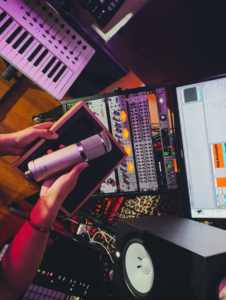Recording live instruments in a studio setting can be a challenging task, but it can also be incredibly rewarding. The process requires careful planning, attention to detail, and the right equipment to capture the sound of the instruments accurately. In this article, we’ll provide some tips for recording live instruments in a studio setting.

Choose the Right Microphones
Choosing the right microphones is crucial when recording live instruments in a studio. Different microphones have different characteristics, and some are better suited for specific instruments than others. For example, condenser microphones are excellent for capturing the nuances of acoustic instruments such as guitars and pianos, while dynamic microphones are ideal for capturing the punchy sound of drums and bass.
Proper Mic Placement
Once you have chosen the right microphones, it’s essential to place them correctly to capture the sound of the instruments accurately. The placement will depend on the type of instrument and the sound you are trying to achieve. For example, placing the microphone near the soundhole of an acoustic guitar can result in a boomy sound, while placing it near the fretboard can produce a brighter tone.
Pay Attention to Room Acoustics
The acoustics of the recording room can have a significant impact on the sound of the recorded instruments. The room should be acoustically treated to minimize reflections and absorb unwanted frequencies. If you’re recording in a room with poor acoustics, you can use sound-absorbing panels or curtains to improve the sound quality.
Use Headphones for Monitoring
Monitoring the sound of the instruments is crucial when recording live instruments in a studio. Using headphones can help you hear the sound of the instruments clearly and make adjustments as needed. It’s important to use high-quality headphones that can accurately reproduce the sound of the instruments.
Record Multiple Takes
Recording multiple takes of each instrument can give you more options when mixing and editing the recordings. It’s also a good idea to record a few different variations of each take, such as playing the same melody with different rhythms or dynamics. This can give you more creative options when mixing the final track.
Focus on Performance
While technical aspects are essential when recording live instruments in a studio, it’s also crucial to focus on the performance of the musicians. Encourage the musicians to relax and play with feeling, and don’t be afraid to let them improvise or experiment with different sounds.
Use Compression and EQ Effectively
Compression and EQ are two essential tools for mixing live instrument recordings. Compression can help to even out the levels of the instruments and make them sound more cohesive, while EQ can help to shape the sound and remove unwanted frequencies. It’s important to use these effects sparingly and only when necessary to avoid over-processing the sound.
Mix in Stages
Mixing live instrument recordings can be a complex and time-consuming process. To make it more manageable, it’s a good idea to mix in stages, focusing on one or two instruments at a time. This can help you to achieve a more balanced and cohesive sound while avoiding getting overwhelmed.
Use the Right Preamps
Preamps are crucial components that amplify the signal from the microphones and send it to the recording system. Using high-quality preamps can significantly improve the sound quality of the recordings. Some preamps are designed for specific types of instruments, such as guitar or bass preamps, and can add unique colour and character to the sound.
Experiment with Different Mic Techniques
There are many mic techniques that you can use to capture the sound of live instruments in a studio. Some techniques, such as the X/Y and ORTF techniques, are designed for stereo recording and can create a wider and more spacious sound. Other techniques, such as close-mic or room-mic techniques, can emphasize different aspects of the sound, such as the attack, sustain, or ambience.
Record in a Comfortable Environment
Creating a comfortable and relaxed environment for musicians can help to improve their performance and creativity. Make sure the studio is well-lit, adequately ventilated, and at a comfortable temperature. Provide comfortable seating, refreshments, and snacks to keep the musicians focused and energized.
Use Reference Tracks for Inspiration
Listening to reference tracks that have a similar sound or style to the music you are recording can provide inspiration and guidance for the recording process. Pay attention to the arrangement, instrumentation, production techniques, and overall sound of the reference tracks, and use them as a benchmark for your recordings.
Master the Final Mix
Once you have finished mixing the live instrument recordings, it’s time to master the final mix. Mastering involves making final adjustments to the sound, such as adjusting the overall volume, adding reverb or other effects, and preparing the track for distribution. It’s best to leave mastering to a professional mastering engineer who has the right equipment and expertise to achieve the best possible sound.
Conclusion
In conclusion, recording live instruments in a studio setting requires careful planning, attention to detail, and the right equipment. By following these tips, you can capture the sound of live instruments accurately and achieve a high-quality recording that showcases the musicians’ skills and creativity. Remember to focus on the performance of the musicians
